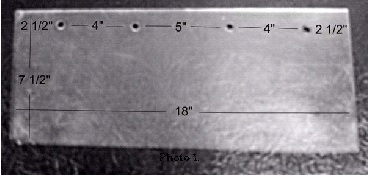

by Tom Carnegie
A bit of history:
When my brother and I first got involved with the Montana 500, low heads were
allowed. The rule was changed in the fall of 1974 to only allow high heads. I
believe the thought was that low heads were getting too hard to find, so why
not only allow high heads, of which there is a good supply. There also might
have been some concern that someone might come up with one of the very early
heads made for flat-top pistons that had a far smaller combustion chamber. As
time went along, folks did some tricky things under the heading of "no limit
to the amount of milling of the head." I have been told that one guy poured a
layer of babbitt into the combustion chamber to increase compression. When he
was sure that his car was declared "legal" at the teardown, he proudly proclaimed
"look what I done!" As you mill a high head, the section in the center is usually
the first part to get weak. To overcome this weakness some folks took to internally
(inside the water jacket) bracing their heads with a piece of angle iron held in
place by an extra bolt. This bolt was then hidden by a temperature sender, or some
such thing. The brace was however discovered during teardown on one car that was
so equipped, and the motor (or rather the driver) was disqualified. As time went
along people got trickier. The deck of the head and the combustion chamber were
sometimes manipulated to allow more milling or to make the combustion chamber
smaller. The club devised a contour gauge to try to stop the chamber manipulation.
No rule, nor any way to police the deck manipulation was found or used. There was
a lot of argument, or maybe "discussion" is a better word, as to whether this
manipulation was illegal or not, with many drivers insisting that it was legal.
Some folks also found out that certain heads, either from Canada, or those made
in US around 1917 had thicker decks than the later ones. I (and probably others)
found that often heads would have a "core shift" when they were cast, so the
combustion chamber was noticeably shallower on some heads than others. Also the
deck, even on early heads are often thicker on some heads than others, presumably
for the same reason. So, if you had a large supply of heads, as I have, you would
go through them all and find the one with the thickest deck and shallowest
combustion chamber, and mill the heck out of it. Even at that though, the heads
would only last so long before they would fold up and die. The group in Spokane
got to talking about this and decided that the Montana 500 shouldn't be a contest
about who can mill their head the most, which is essentially what it had become.

Use some modeling clay to fill the sparkplug hole flush. Invert the head and stabilize it so that the valve side is slightly lower. Place the Plexiglas onto the deck, sealing it with the grease. Proceed to fill the chambers with water from the syringe, being careful to keep track of how much water you use.